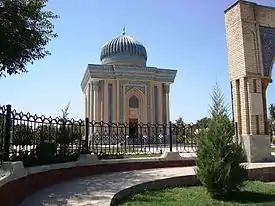Baha' al-Din Naqshband
Baha-ud-Din Naqshband Bukhari (Persian: بهاءالدین محمد نقشبند بخاری) (1318–1389) was the founder of what would become one of the largest Sufi Sunni orders, the Naqshbandi.
Syed Baha-ud-Din Naqshband Bukhari | |
|---|---|
 Baha-ud-Din's name in Arabic calligraphy | |
| Born | 1318 Bukhara, Chagatai Khanate |
| Died | 1389 (aged 70–71) Bukhara, Timurid Empire |
| Venerated in | |
| Influences | Prophet Muhammad, Ali ibn Abi Talib, Abu Bakr, Jafar Sadiq, Amir Kulal, Abdulkhaliq Ghujdawani |
| Influenced | Yaqub al-Charkhi, Hazrat Ishaan, Moinuddin Hadi Naqshband, Sayyid Mir Jan, Sayyid Mahmud Agha |
| Part of a series on Islam Sufism |
|---|
|
|
Biography
Baha-ud-Din was born on 18 March 1318 CE (14 Muharram, 718 AH) in the village of Qasr-i-Hinduvan (later renamed Qasr-i Arifan) near Bukhara, in what is now Uzbekistan and it was there that he died in 1389.[1]
Lineage
Baha-ud-Din was a Sayyid, a descendant of Prophet Muhammad through Imam Hasan al-Askari. One registered lineage of him is the following:[2][3]
2. Ali ibn Abi Talib and Fatima Al Zahra
3. Imam Hussain
5. Imam Muhammad al Baqir
9. Imam Muhammad al Taqi
10. Imam Ali al Hadi
13. Sayyid Mir Mahmud Fakhriddin
14. Amir Sayyid Mir Muhyuddin
15. Amir Sayyid Mir Khalwati
16. Amir Sayyid Mir Naqi Naqib
17. Sayyid Mir Ilaq
18. Sayyid Mir Mahmud
19. Sayyid Burhan Qilich
20. Sayyid Mir Shaaban
21. Sayyid Mir Qasim
22. Sayyid Mir Zayn ul Abedin
23. Sayyid Mir Abdullah
24. Sayyid Mir Burhanuddin Qilich
25. Amir Sayyid Mir Jalalludin Muhammad Bukhari
26. Amir Sayyid Burhanuddin Muhammad Bukhari
Naqshbandi Golden Chain
He came into early contact with the Khwajagan (lit: the Masters), and was adopted as spiritual progeny by one of them, Baba Muhammad Sammasi, while still an infant. Sammasi was his first guide on the path, and more important was his relationship with Sammasi's principal khalifa (successor), Amir Kulal, the last link in the silsila, or chain of teachers, before Baha-ud-Din:[5]
- Muhammad
- Sayyidna Abu Bakkar Siddique
- Salman the Persian
- Qasim ibn Muhammad ibn Abu Bakkar
- Ja'far al-Sadiq
- Bayazid Bistami
- Abu al-Hassan al-Kharaqani
- Abu Ali Farmadi
- Abu Yaqub Yusuf al-Hamadani
- Abdul Khaliq al-Gajadwani
- Arif ar-Riwagri
- Mahmood Anjir-Faghnawi
- Azizan Ali Ramitani
- Sayyid Amir Kulal
- Mohammad Baba As-Samasi
- Imam at-Tariqah Muhammad Baha'uddin Shah Naqshband
As a youth, Naqshbandi was recognized as an exceptional Islamic scholar before he turned 20. He traveled to Mecca for the Islamic pilgrimage Hajj at least three times. He became a respected scholar in Central Asia and received many guests and pupils to Bukhara from other parts of Central Asia.[6]
Death
Baha-ud-Din was buried in his native village, Qasr-i Arifan, in 1389. In 1544, Khan Abd al-Aziz built over his grave a tomb and surrounding buildings. The Memorial complex is located 16 kilometers from Bukhara and is today a place of pilgrimage.[7]
Legacy and descendants
Baha-ud-Din is the founder of the Naqshbandi Sufi order.
One notable bloodline goes on through his daughter who married Bahauddin’s student and spiritual heir Alauddin Attar. Notable descendants of Bahauddin through this bloodline are Hazrat Ishaan and his family.[8]
See also
References
- "Yawm-A-Wilaadat Hazrat Khwaja Shah Bahaudeen Naqshband Qaddas Allahu Sirruhul Azeez". 17 November 2013. Archived from the original on 2013-12-27.
- Tazkare Khanwade Hazrat Ishaan, p. 62 f., by Yaseen Qasvari, published by "Idarat Talimate Naqshbandiyya"
- https://shajara.org/2020/06/24/naqshbandiya-shajarasi-izidan/ Naqshbandiya shajarasi izidan
- "Shajara-e-nasab lineages of descendants of Imam Hasan al-Askari r.a.-Shajara.org". Retrieved 2020-06-29.
- Sultanova, Razia (2011). "Naqshbandiyya". From Shamanism to Sufism. I.B.Tauris. p. 32–37. ISBN 978-1-84885-309-6.
- Mullerson, Rein (2014). Central Asia. Taylor and Francis. ISBN 9781317792529.
- Mullerson, Rein (2014). Central Asia. Taylor and Francis. ISBN 9781317792529.
- Tazkare Khanwade Hazrat Ishaan, p. 62 f., by Muhammad Yaseen Qasvari, edited by: Idare Talimat Naqshbandiyya
Further reading
- The Rules or Secrets of the Naqshbandi Order by Omar Ali-Shah (1992) ISBN 2909347095
- The Masters of Wisdom by John G. Bennett (1995) ISBN 1881408019
- The Naqshbandi Sufi Way, (History and Guidebook of the Saints of the Golden Chain). by Shaykh Muhammad Hisham Kabbani. Kazi Publications, USA (1995) ISBN 0-934905-34-7
- Classical Islam and the Naqshbandi Sufi Tradition, Shaykh Muhammad Hisham Kabbani, Islamic Supreme Council of America (June 2004), ISBN 1930409230.
External links
| Wikimedia Commons has media related to Baha-ud-Din Naqshband Bukhari mausoleum. |
- The official website of Shaykh Zulfiqar Ahmad Naqshbandi the patron of Naqshbandi-Mujaddidi Order in East and West.
- The official website of the Naqshbandi-Haqqani Sufi Order of America
- Naqshbandia Owaisiah
- Ghazwat ul-Hind
- The official website of the Naqshbandiyya-Mujaddidiyya Order of the USA and Europe
